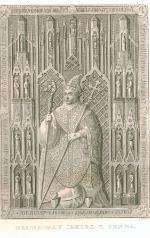Jakub of Sienno
Jakub of Sienno (Polish: Jakub z Sienna) was a medieval Bishop Kraków in the years 1461-1463, Bishop of Włocławek from 1464,[1] and then Archbishop of Gniezno from 1474.[2][3][4][5] He was also a 15th century diplomat for the Polish Crown.
Family
Jakob was born in 1413 in Sienno, the son of Dobisław of Oleśnicy a local aristocrat of the Debno family and his wife Catherine Oleśnicka, daughter of Dymitr of Goraj. His father, Dobiesława Olesnica mala Dębno, was Count of Sandomierz.
His brothers were:
- John of Sienna Castellan of Lwów
- Dymitr of Sienna (d. 1465) Canon of Kraków
- Nicholas of Sienna (d. 1484) Archdeacon of Sandomierz
- Paul of Sienna (c. 1410-1444) the Royal Secretary
- Andrzej Sienieński (d. 1494) Chamberlain of Sandomierz
- He was also a nephew of Cardinal Oleśnicki.
Early life
He studied law and Theology in Rome and from 1435 was a Canon of Kraków Cathedral. As a diplomat he served as Secretary of KingVladislav Varnenchik and King Casimir IV Jagiellon.
As a diplomat he was sent on missions to Hungary in 1442 and 1448 and in 1459 he represented the King at the Congress of Mantua.[6]
Diplomatic career
He was sent on a diplomatic missions in 1442 to Hungary, in 1448AD to Rome. After the death of his uncle Cardinal Zbigniew Oleśnicki in 1455 was elected administrator of the Diocese of Kraków.
In 1459 he represented the King at the Congress in Mantua. November 24, 1460,
Episcopal career
After the death of his uncle, Cardinal Zbigniew Oleśnicki, in 1455 he was administrator of the diocese of Kraków.
Pope Pius II appointed him Bishop of Kraków. Unfortunately, the King had other plans and request the appointment of John Gruszczynski, consecrated on May 31, 1461.[7] The conflict escalated with the Pope (Pius II) on 2 June 1461, threatening to excommunicate the King. The King then banished Jakub.

Eventually on 16 January 1462 the conflict was resolved through intersession of the papal legate Jerome Lando, Archbishop of Crete. In January 1463 at the Sejm in Piotrków the Kings appointee abdicated the bishopric of Kraków.
Pope Pius II compensated Jakob and he received the bishopric of Włocławek. In Wloclawek and in Gniezno he installed oak pew stalls and rich liturgical equipment, and donated to the library of Kraków Academy.
In 1465 he represented the King at the meeting with the Teutonic Knights in Toruń, that ended the thirteen-year war.
In 1466 he represented the King during the discussions with the Teutonic Knights in Toruń, ending the 13-year-old war. He was a signatory to the Act of peace of 1466.[8]
He died 4 October 1480 in Łowicz and was buried in the Cathedral of Gniezno. He erected the cross on the Cathedral, still there today.
References
- ↑ "Diocese of Włocławek (Kujawy, Kalisze)". Catholic-Hierarchy.org. David M. Cheney. Retrieved 23 January 2015.
- ↑ Marceli Kosman: Między ołtarzem a tronem : poczet prymasów Polski. (Poznań: Oficyna Wydawnicza G & P, 2000).
- ↑ Antoni Gąsiorowski, Jerzy Topolski [ed.]: Wielkopolski Słownik Biograficzny. (Warszawa-Poznań: Państwowe Wydawnictwo Naukowe, 1981), p276-277.
- ↑ David m. Cheney:[www.catholic-hierarchy.org Archbishop Jakub Sienienski] (Sienna) at Catholic Heirachy (access to 2013-06-27).
- ↑ Archdiocese History Biography of Jakob.
- ↑ Marceli Kosman: between the altar and the throne: the Polish primates. Poznań, Poland: Oficyna Wydawnicza G & P, 2000. ISBN 83-7272-017-7.
- ↑ David M. Cheney: Archbishop Jakub Sienienski (z Sienna).
- ↑ Volumina Legum, volI, (Petersburg 1859), p101.